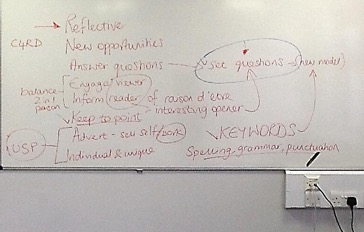Self-efficacy can be defined as an individual’s own perception of their ability to achieve goals. It is similar to, but more potent than, self-confidence. An increase in self-efficacy often results in more difficult tasks being attempted with greater commitment, greater resilience and higher levels of success. Self-efficacy is context specific, which enables it to be targeted at very precise goals. It is also influenced by social agency – the interaction of individuals within a particular environment. Thus, one way in which self-efficacy can be developed is through group workshops being hosted on challenging topics.
The workshop shown as an exploratory tool on the adjoining page is an example of how self-efficacy can be promoted via simple practical exercises that are of professional value, such as the writing of an ‘artist’s statement’. NB: the original style and layout of this exploratory tool has been retained to reflect the nature of the materials as encountered by students at the moment of delivery.

Notes from class discussion regarding the purpose(s) and features of an artist statement
To explore the purpose and features of the artist statement
To develop some techniques for enabling writing
Use the workshop environment to share ideas and enhance each student’s perceived sense of self-efficacy regarding the writing of an artist statement
Sketchbook or a piece of work by the student
Worksheets for each model
Students need to bring at least one piece of work or a sketchbook to enable them to have the most authentic and relevant experience.
It is important that each student is required to consider each of the models in relation to their own work. This limits the possibility of a negative impact on self-efficacy caused by a student not liking one or more of the models.
This workshop has been run successfully in a one hour time slot. This relatively short duration has been used so that the focus remains on the models rather than the writing, thus encouraging consideration and critique of the methods themselves. Students were offered the option to book individual appointments to follow up the workshop and discuss their own writing.
This was adapted from an exercise provided by Nancy de Freitas at a Writing PAD workshop, ‘Towards effective academic journal publication’ at Staffordshire University in 2013.
There should be multiple rows to allow ideas to be developed.


Use this to list events then identify cause and effect, and select most significant moments and why.

To test whether students had ‘employability’ in mind when they chose their course, we asked them. However, depending on how the question was phrased, we got a range of answers and ‘employment’ was, by no means, the only or major goal of the student.
It seemed that we had to ask the question in many different ways in order to collect a truly representative array of ambitions and objectives. Apart from wanting to ‘learn skills’, students repeatedly talked about wanting to develop their confidence, not just in their subject area, but personally also.
This workshop began with the premise that whatever students might want to go on to do with their degree, it will be in a competitive world. From this a number of questions arose:
Students worked in course-specific groups and were asked to identify the parts of their programme that built or knocked their confidence. They then went into more detail and discussed how these different parts of the course delivery affected confidence. As one might expect some things, like assessment and tutorials, sat in both columns and often centred around individual approaches.
With these discussions in mind, the groups were then asked to design their own ‘super course’, in which confidence building was top of the agenda.
Workshop: What would your ideal course look like?
Ideas tended to be course-specific and the notion of designing a ‘super course’ soon overtook the issue of confidence building. However the workshop did highlight areas of delivery which might be reviewed, and suggested that ‘how’ was just as important as ‘what’. It was clear that the students enjoyed the collaborative aspect of the day, (particularly meeting students from another institution), as well as having the opportunity to give feedback and have creative input into the directing of their course. This did as much for their confidence as anything else.